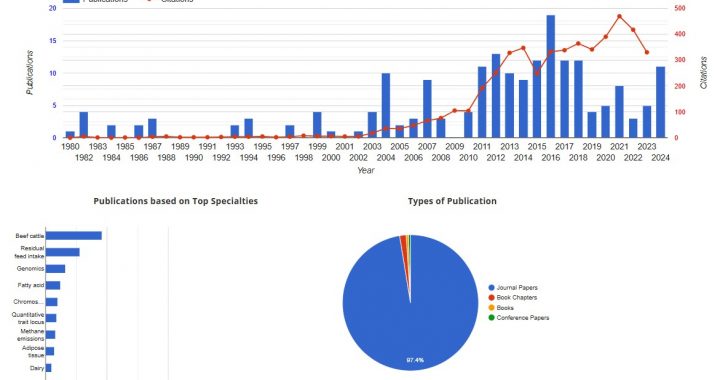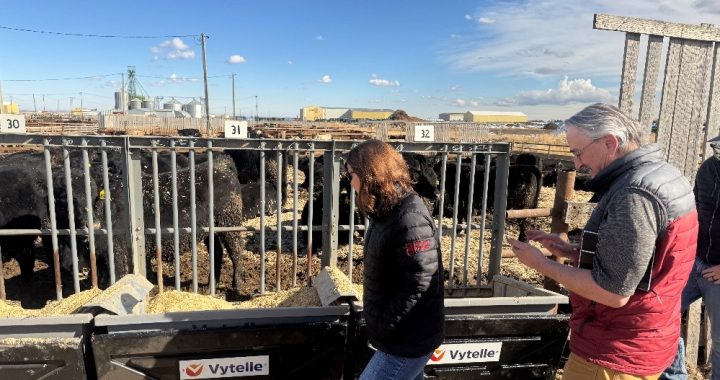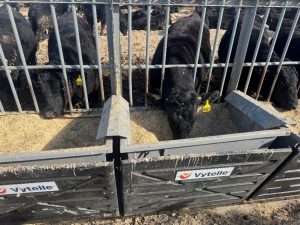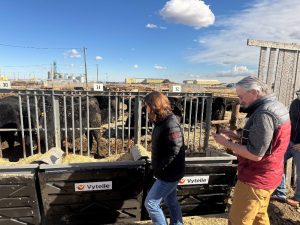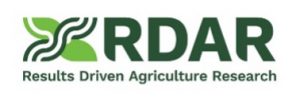One of Gentec’s Core Values is the transfer of science into practice by getting knowledge and tools directly into the hands of producers.
We focus on developing research projects that deliver clear value to the industry – often driven from the questions and needs from the industry itself. In doing so, we not only find answers to industry questions, but also help train the next generation of industry leaders.
We bring science into practice in many ways—through participation in industry conferences, local producer-focused meetings, podcasts, media interviews, farm visits, and on-farm team training, to name a few. We also focus on developing practical tools and resources that support informed, data-driven decision-making at the farm level.
Below are a few examples of how the Gentec Swine KKT team has been active in fulfilling our commitment.
Conference Spotlight: Science Meets Practice in Gilt Development
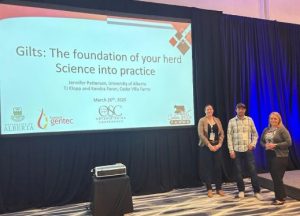 On March 25-26th, Gentec’s Jenny Patterson was an invited speaker at the 2025 Ontario Swine Conference– marking the first year the London Swine Conference and Ontario Pork’s Annual General Meeting werecombined. The conference provided science-backed insights to help drive progress in Ontario’s swine sector with over 500 of the industy’s best in attendance.
On March 25-26th, Gentec’s Jenny Patterson was an invited speaker at the 2025 Ontario Swine Conference– marking the first year the London Swine Conference and Ontario Pork’s Annual General Meeting werecombined. The conference provided science-backed insights to help drive progress in Ontario’s swine sector with over 500 of the industy’s best in attendance.
Jenny joined TJ Klopp and Kendra Foran from Cedar Villa Farms in a session titled “Gilts: The Foundation of Your Herd – Science into Practice”. Together they delivered a combination of science based research findings with the practical on-farm side of raising and managing replacement gilts. TJ, a 7th-generation farmer from Zurich, ON, and Kendra, the Barn Manager at Cedar Villa’s Gilt Developer Barn, shared how their operation—marketing 100,000 hogs annually—puts science into practice.
Producer Meeting: Knowledge transfer to Alberta Producers
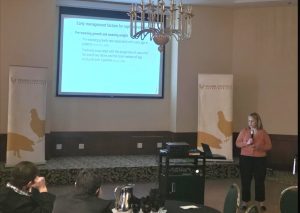 On April 30th, 2025, Jenny Patterson was a special guest speaker at the Prairie Livestock Veterinarians Producer Meeting in Strathmore, Alberta. The event brought together a small group of Alberta producers for discussions on key industry topics.
On April 30th, 2025, Jenny Patterson was a special guest speaker at the Prairie Livestock Veterinarians Producer Meeting in Strathmore, Alberta. The event brought together a small group of Alberta producers for discussions on key industry topics.
PLV Veterinarian’s Dr. Jessica Law presented on “Industry and International Disease Updates” and Dr. Rienske Mortier spoke on “Practical Treatment and Euthanasia”. Jenny’s session, focused on “Gilt Development – Start with the End in Mind“.
PodCast Alert: Strengthening Gilt Development for Long-Term Productivity
 In March, Jenny was invited to the Popular Pig Podcast with Matthew Rooda. The Popular Pig Podcast presents information on the latest trends, news, and research from various experts that guide the global pork industry.
In March, Jenny was invited to the Popular Pig Podcast with Matthew Rooda. The Popular Pig Podcast presents information on the latest trends, news, and research from various experts that guide the global pork industry.
As highlighted, Jenny and Matt discussed a variety topics including “Why a strong gilt development program is key to narrowing the gap between genetic potential and on-farm performance”, “How early culling and poor retention after parity one are major roadblocks to sow lifetime productivity—and what can be done about it”, and “What “fertility quadrant” targets you should hit for optimal breeding success—and why data and body condition tracking post-parity1 are just as vital”.
Strengthening Gilt Development for Long-Term Productivity | Jennifer Patterson
Research in Action: Gentec Back in the Barn with the NSERC Alliance Project
Our NSERC Alliance project with our research partner Hypor Genetics in Saskatchewan continues to move forward. This 4-year project will identify the underlying genetic and phenotypic relationships between different traits in order to achieve more balanced selection to improve sow lifetime productivity, production profitability and sustainability.
We are back in the barn this summer collecting more data and learning new things! We are delighted that Morgan Rioch joined us again, we highlighted her in the “Delicious Bits” article in August 2024.
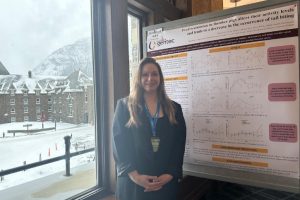 New to the barn this summer, is of our MSc student, Kayla Patey. Kayla completed a Bachelor of Science in Agriculture, Animal Science at the University of Guelph in 2023 and joined the Gentec team in November 2023 as a Research Assistant, presenting her first poster at the Banff Pork Seminar in January 2024. Before that, Kayla left an exciting career in the gaming and film industry, first earning a diploma in Game Development before coming back to her agriculture roots.
New to the barn this summer, is of our MSc student, Kayla Patey. Kayla completed a Bachelor of Science in Agriculture, Animal Science at the University of Guelph in 2023 and joined the Gentec team in November 2023 as a Research Assistant, presenting her first poster at the Banff Pork Seminar in January 2024. Before that, Kayla left an exciting career in the gaming and film industry, first earning a diploma in Game Development before coming back to her agriculture roots.
Kayla’s focus will be related to “Litter of Origin Traits” and how pre-weaning growth performance is associated with pre-weaning mortality and subsequent selection and performance in the gilt pool.
Science into Practice: Supporting the farm team
A key part of Jenny’s role at Gentec is supporting Alberta’s producers by putting “Science into Practice”.
Jenny collaborates with industry groups with a focus on gilt management, with the goal of improving lifetime productivity and retention. She loves working with farm production data, through which powerful insights can be developed to make data-driven decisions that positively affect overall herd performance.
Through on-farm visits and virtual calls, Jenny connects with the people who make it all happen—the farm teams—looking at farm data and showing how it translates into day-to-day practices related to gilt development and sow lifetime productivity. In the December 2024 issue of Delicious Bits we shared positive feedback from an industry partner that our activities are helping get the information “to the people in the barn who can make the difference in performance”.

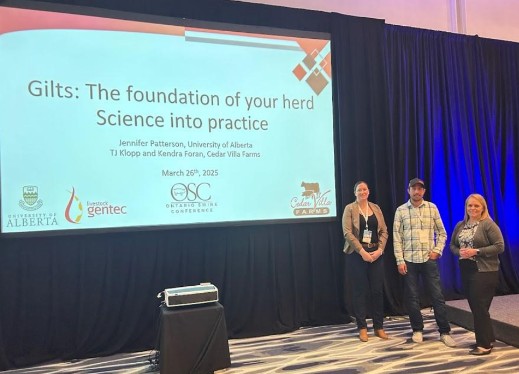
 On March 25-26th, Gentec’s Jenny Patterson was an invited speaker at the
On March 25-26th, Gentec’s Jenny Patterson was an invited speaker at the  On April 30th, 2025, Jenny Patterson was a special guest speaker at the
On April 30th, 2025, Jenny Patterson was a special guest speaker at the  In March, Jenny was invited to the Popular Pig Podcast with Matthew Rooda. The Popular Pig Podcast presents information on the latest trends, news, and research from various experts that guide the global pork industry.
In March, Jenny was invited to the Popular Pig Podcast with Matthew Rooda. The Popular Pig Podcast presents information on the latest trends, news, and research from various experts that guide the global pork industry. New to the barn this summer, is of our MSc student, Kayla Patey. Kayla completed a Bachelor of Science in Agriculture, Animal Science at the University of Guelph in 2023 and joined the Gentec team in November 2023 as a Research Assistant, presenting her first poster at the Banff Pork Seminar in January 2024. Before that, Kayla left an exciting career in the gaming and film industry, first earning a diploma in Game Development before coming back to her agriculture roots.
New to the barn this summer, is of our MSc student, Kayla Patey. Kayla completed a Bachelor of Science in Agriculture, Animal Science at the University of Guelph in 2023 and joined the Gentec team in November 2023 as a Research Assistant, presenting her first poster at the Banff Pork Seminar in January 2024. Before that, Kayla left an exciting career in the gaming and film industry, first earning a diploma in Game Development before coming back to her agriculture roots.